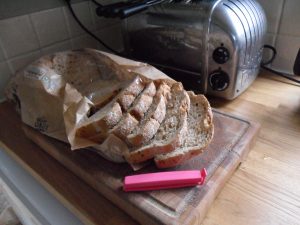
In all the time I’ve been working in waste (not literally, although check out my profile picture where I’m doing just that with Jimmy Doherty) the most shocking statement I’ve come across is that – brace yourselves – in this country we waste the equivalent of 24 million slices of bread a day.
24 MILLION SLICES:
- You’d need a toast rack as high as 27 Mount Everests!
- Two days’ worth of bread waste would reach the International Space Station!
The good old-fashioned loaf, our daily bread, is THE most wasted product in the UK according to WRAP. We bin 460,000 tonnes of standard bread a year and 350,000 tonnes of that are ‘avoidable’ or in other words, perfectly good. The majority of bakery waste (c.80%) is standard bread, costing £550 million a year.
Most bakery products are wasted because we don’t use them in time, which reflects their relatively short shelf-life. The same is true of that other staple, the humble potato. Interestingly, for rice and pasta the main reason for disposal is preparing, cooking or serving too much, which, in my experience, is down to most of us being pretty poor at portioning foods that expand with cooking.
But back to bread. It takes 10 months to grow wheat for bread. Most is planted in autumn and typically 30% doesn’t survive the winter, yet 2% of bread isn’t even taken out of its packaging before being thrown away. This is more than a little discourteous when you consider how easy it is to save a loaf (not to mention the time, effort and resources that went into it) by freezing it.
Loaf-saving skills
- Bread freezes brilliantly. My top tip is to bang it (gently) on the worktop before putting it into the freezer, because it helps to separate the slices, which is better than setting about it with a chisel. Then you simply make toast straight from the freezer, as and when you need to, and in my opinion, this is the best use for it; although you can build a butty (sandwich) between frozen slices, which will defrost by lunchtime keeping the filling cool to boot. We’ve also blitzed frozen bread into crumbs, but it’s tough stuff, so be sure your whizzer is up to the job to avoid an expensive breakage.
- Don’t keep bread in the fridge. The dryness of the air encourages loss of water (transpiration) and it will stale six times quicker in there. The best place to store bread is in a cool, dry place such as a bread bin or cupboard.
- Seal open bags with a clip – or even a peg – to keep your loaf fresher for longer and if you’re not going to get through it, freeze it.
- Hot date? Bread usually has a Best Before. (Some in-store bakery items have a Use By.) Best Before is about quality, not safety, so food is fine to eat after that date; it just won’t be at its very best (like most of us). It’s important to note here that if a product has a Use By, you shouldn’t eat it after that date – even if it looks and smells fine.
For us, saving bread isn’t about making endless bread and butter/summer puddings or Instagramming home-made croutons from crusts, it’s about buying a bit less, using what you buy and having a bit more respect for those who spend their time in the worst of the winter weather tending to their crops.
Bread is often considered cheap, ordinary fayre available 24/7, yet in many other countries and cultures it is the most significant of foods. Let’s make this precious.

Great post. I cant believe I spend 10 years with sarmies that got a bit less fresh tasting each day of the week as I use 1 loaf a week even though I got unsliced so it lasted better. It means it’s worth buying nicer bread and asking for it sliced and the overall cost is reduced because of the lack of waste